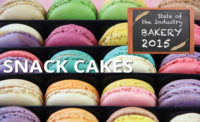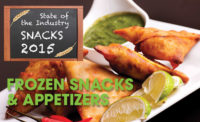When it comes to the snacks they eat, Americans are becoming ever more vigilant about the ingredients they contain and how they’re made. They want better-for-you products that are made with simple, recognizable ingredients and are less processed.
Overview | Chips | Puffed/Extruded Snacks | Popcorn | Snack Mixes & Nuts | Tortilla Chips | Pretzels | Frozen Snacks | Crackers
And yet, within the past year, consumers have purchased 767.38 million bags of Frito-Lay’s Cheetos Cheese Snacks, for the 52 weeks ending May 17, 2015, according to IRI, Chicago. They’ve also nibbled their way through millions of bags of other popular puffed and extruded snacks this year.
People know what they like, and despite prevailing health-and-wellness trends, they are open to occasional indulgences.
Consumers are also discovering that, contrary to their appearance, many of today’s puffed and extruded snacks offer the attributes they seek in a snack—nutritious ingredients, delicious flavors and a satisfying crunch, to name a few. And the fact that more products are now available baked or air-popped—instead of fried—makes them even more of a go-to snack for health-conscious consumers.
Market data
Cheese snacks, corn snacks (excluding tortilla chips) and other salted snacks (excluding nuts) all fared well during the 52 weeks ending May 17, 2015, according to IRI. Of the eight product subcategories in the salty snacks category—which saw sales increase 4.55 percent over the same prior-year period to $21.25 billion—other salted snacks (excluding nuts) experienced a 4.78 percent jump in dollar sales to $3.75 billion. Cheese snacks saw dollar sales increase 5.96 percent to $1.88 billion, while corn snacks (excluding tortilla chips) saw dollar sales climb 3.20 percent to $1.09 billion.
Frito-Lay North America was the clear front-runner in the other salted snacks (no nuts) subcategory, with sales of $2.30 billion for the 52-week period, per IRI. General Mills, Minneapolis, was a distant second in the category with $509.00 million in sales.
Frito-Lay was also the leader in the cheese snacks subcategory, significantly outperforming competitors with $1.61 billion in sales the 52-week period, an increase in dollar sales of 6.22 percent for the year. In fact, it sold more than three times as many cheese snacks than private label cheese snacks ($48.98 million), which were second in the cheese snacks subcategory. Frito-Lay’s Cheetos Cheese Snacks is the clear brand leader, with $1.41 billion in sales, a 7.68 percent increase in dollar sales. The company’s Cheetos Simply Cheese Snacks saw the largest percentage increase in dollar sales among cheese snacks at 301.57 percent for $25.57 million in sales.
Frito-Lay topped the corn snacks (excluding tortilla chips) subcategory, too, with $821.32 million in sales for the 52-week period, per IRI, a 5.13 percent increase in dollar sales. Frito-Lay Corn Snacks, Scoops! Corn Snacks and Flavor Twists Corn Snacks were the three top-selling brands, with the latter reporting a sales increase of 87.96 percent.
Looking back
As with most snack products, numerous trends are driving sales in the extruded snacks category. Consumers’ quest for better-for-you snacks and quality ingredients are key factors.
“Non-GMO, gluten-free and better-for-you are three trends driving most of the growth in the snack aisle,” says Paul Albrecht, vice president, Simply 7 Snacks, Houston. “People are making snacking a part of their healthy daily diet and are looking for better options. Portable protein and ancient grains are two other growing trends.” Simply 7 Snacks’ gluten-free Quinoa, Hummus and Lentil Chips are made with simple ingredients and contain no trans fat, cholesterol, preservatives, artificial colors or artificial flavors.
“Consumer trends driving puffed and extruded snacks in our market include the better-for-you segment to some degree, but mostly revolve around the ‘natural’ qualities of the product and its inputs,” says Luke Mapp, director of sales and marketing services, Mikesell’s Potato Chip Co., Dayton, OH. The company’s product line includes Cheese Curls and Puffcorn Delites.
Similarly, Rose Ayres, associate brand manager, Barbara’s, Weetabix and Alpen, Weetabix North America, Marlborough, MA, says better-for-you snacking is about “more than just the nutritional facts, it is also about the quality of ingredients used to create the product.” The company currently offers Barbara’s Cheese Puffs in Original, Jalapeño, Baked Original and Baked White Cheddar. All are made with non-GMO stone-ground corn.
Extrusion experts have grown quite adept at creating interesting snack shapes. Bob Clark, vice president of marketing, Herr Foods Inc., Nottingham, PA, notes that curls, balls and wheels are easily achieved in extruded snacks today. “You can even create character or animal shapes just by changing the cut-out wheel of the extrusion,” he adds. “That area is becoming more dynamic.” Herr Foods plans to offer Halloween trick-or-treat packs this year featuring bat- and spider-shaped snacks. The company currently offers Herr’s Sweet ’N Crunchy Cotton Candy Balls.
Mapp says he sees a majority of the flavor profiles steering toward dairy—including cheese and butter—and spicier options, aspects seen in the Mikesell’s Southwestern Queso Con Cheese Curls, introduced last August.
Herr’s has seen a lot of growth in its Cheese Curls, says Clark, because of its new, more-intense flavors, such as Buffalo Blue Cheese and Old Bay Seasoned, introduced last summer. “They’re indicative of the kind of flavor explosion that’s going on in the cheese curl category,” he notes.
Herr’s Jalapeño Poppers Cheese Curls also continues to do well for the company. “Cheese curls have typically appealed to younger generations,” Clark says. “I think as kids grow up, they still enjoy the experience of Cheese Curls, but they like to have more-interesting flavors on them.”
Inventure Foods introduced a number of innovative extruded snacks in the past year under its various brands, including Boulder Canyon Baked Veggie Sticks, which feature 10 organic vegetables and are gluten-free and non-GMO; Vidalia Zesty Ranch Sweet Onion Petals; and Nathan’s Famous Beer Battered Onion Rings.
TGI Friday’s Cheddar Cheese Jalapeño Poppers, which were introduced in 2013 and combine Cheddar with heat, has done “really well” for the company, says Steve Sklar, senior vice president and general manager, Inventure Foods Inc., Phoenix. “Needless to say, our extrusion machines are running quite often, as we are seeing great consumer interest in these new snacks.”
Looking forward
Today’s market continues to focus on healthy snacks made with a wider range of raw materials, notes Mike Shaw, sales account manager, Bühler Group, Plymouth, MN—particularly nontraditional ingredients, such as ancient grains, legumes and beans, and gluten-free ingredients. Snack producers are also exploring vegetable protein sources, he says, in new flavors and formats.
“Probably the biggest growth is in the ancient grains,” says Brian Anderson, vice president of marketing and innovation, Bunge North America, St. Louis. “They’re creeping into a lot of the boutique snacks that are coming out.”
Because ancient grains can offer suppliers and manufacturers challenges, suppliers need strategic approaches for ingredient handling. Anderson notes that his company only carries ancient grains that can be procured year in and year out, “so we’re taking a heavy stance in sorghum and millet.”
The company also had to decide whether to sell ancient grains whole or ground. “We figured out how to mill smaller grains,” says Anderson. “We make a refined version that you can easily substitute for a corn, rice or wheat, or you can get the whole grain. We’re trying to offer more options to make it easier to formulate, which led to the third part of our strategy.
“If you look at most of the inclusion rates for whole grains,” Anderson continues, “it’s 5 to 10 percent. We’d like to see that at 40 to 50 percent of the formula. You’re going to have processing issues on the extrusion side, but I think once the industry starts working on it and adapting, it’ll figure it out. People have figured out the whole-grain scenario.”
Using a variety of traditional and nontraditional ingredients allows manufacturers to create a strong range of better-for-you puffed and extruded products. “Producers are getting very creative with extruded snacks now, and the offerings are quite varied,” says Albrecht. “The most-popular options are either the traditional veggie chips or sticks—though now they are being supplemented with more nutrition, or made ‘skinny’ with less fat—and those with more unique bases.”
Shaw notes that snack manufacturers and consumers also seem to be more interested in more sophisticated products like coextruded or filled snacks. Often presented as sweet and savory snacks, these items can blur traditional product line distinctions between snacks, cookies, crackers and cereals, he adds.
How puffed and extruded snacks are produced is also a purchasing consideration for some consumers. “I believe consumer interest in better-for-you foods bolsters interest in extruded snacks, as the cooking process relies very little on frying in oil,” says Sklar. “The combination of external heat and pressure does most of the cooking, and the baking process is mostly about removing moisture to form that perfect crunch.”
Considering the wide range of approaches to these snacks, equipment flexibility is key to quick responsiveness to trends. “The flexibility of twin-screw extrusion technology allows manufacturers to adjust a number of parameters in the extruder to achieve different eating characteristics,” explains Shaw. “Screw configuration, screw speed, injection of liquids/steam, die design and a number of other factors can be configured to give the appropriate amount of thermal and/or mechanical cooking to achieve a wide range of end-product attributes.”
Ribbon blenders help extruded snack manufacturers mix grains, flours, oil, sugar, emulsifiers, extrusion aides and other ingredients, says Christine Banaszek, application engineer, Charles Ross & Son Company, Hauppauge, NY. Once blended, manufacturers can add water to the batch to raise moisture content to the proper level for extrusion. Polished interior stainless steel surfaces and radiused welds promote homogeneous blending, complete discharge and fast cleaning during changeover.
Like other snack producers, manufacturers of extruded snacks face a number of challenges in bringing their products to market. “It’s a competitive category,” says Clark. “There are a lot of new products coming out all the time. Coming up with something special and breaking through, you’ve got to be creative. People are looking for new things all the time. Moms, especially, want to purchase things for their whole family that they feel good about.”
Snack producers are tasked with building a wide range of appeal. “Achieving a product that appeals to the health-conscious side of shopping moms, tastes delicious and appeals to the fun side of the younger generation can be challenging,” says Mapp. Getting retailers to carry new products can prove challenging as well, he adds.
“Most of the space is still reserved for traditional style chips,” says Albrecht. “It’s a constant battle to grow the variety.”
And then there’s the issue of ingredient availability, especially when creating products that are organic, allergen-free, non-GMO and so on. Ayres notes that the biggest challenge Barbara’s faces in producing Barbara’s Cheese Puffs is sourcing non-GMO corn grown in the U.S. “Corn is a high-risk crop that has many requirements for it to be non-GMO-verified, and the majority of farmers in the U.S. are not able to meet these guidelines,” she says.
But, overall, manufacturers of puffed and extruded snacks remain optimistic about the future and growth of their category, citing continued consumer demand for healthier snacks and extruded snacks’ versatility as key factors.
“Everything is looking up,” Albrecht says. “This is where all the growth is for the snacks category as a whole—and that shows no sign of slowing down. Because of the flexibility of the style of chips, there are numerous opportunities for companies to innovate.”
Sklar expects more growth in coextruded “stuffed” snacks, and increased development of better-for-you snacks across the aisle.
“I think the outlook for this category is strong,” says Clark. “We’re seeing it continue to grow, and we think this is a good product format to carry flavor, so it hits that trend. It also has a better-for-you side to it.”
Overview | Chips | Puffed/Extruded Snacks | Popcorn | Snack Mixes & Nuts | Tortilla Chips | Pretzels | Frozen Snacks | Crackers











